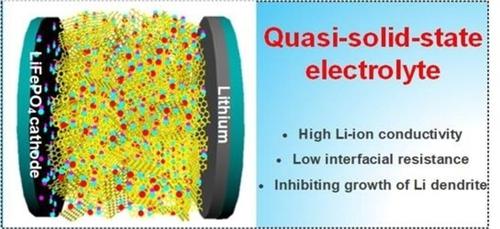当前位置:
X-MOL 学术
›
Batteries Supercaps
›
论文详情
Our official English website, www.x-mol.net, welcomes your
feedback! (Note: you will need to create a separate account there.)
Functional Covalent Triazine Frameworks‐Based Quasi‐Solid‐State Electrolyte Used to Enhance Lithium Metal Battery Safety
Batteries & Supercaps ( IF 5.1 ) Pub Date : 2020-05-06 , DOI: 10.1002/batt.202000069 Qing Xuan Shi 1 , Xin Guan 1 , Hui Jie Pei 1 , Chen Chang 1 , Hao Qu 1 , Xiao Lin Xie 1 , Yun Sheng Ye 1
Batteries & Supercaps ( IF 5.1 ) Pub Date : 2020-05-06 , DOI: 10.1002/batt.202000069 Qing Xuan Shi 1 , Xin Guan 1 , Hui Jie Pei 1 , Chen Chang 1 , Hao Qu 1 , Xiao Lin Xie 1 , Yun Sheng Ye 1
Affiliation

|
The development and use of lithium metal batteries (LMBs) has been hampered by uneven Li deposition and dendrite formation during repeated cycling. Here, a new class of quasi‐solid‐state electrolytes (QSSE) consisting of ionic liquid functional covalent triazine‐based frameworks (IL‐fCTF) and a Li salt‐ionic liquid (LIL), formed by simple mechanical mixing, is shown to overcome these problems. The IL‐fCTF based QSSE exhibits high strength stability, due to its robust CTF skeleton that suppresses unwanted Li dendrite formation. Moreover, LIL absorbed in the ordered porous structures of the CTF skeleton forms three‐dimensional (3D) continues ion transport channels, beneficial for Li‐ion conduction and ensuring even Li deposition. The QSSE used in LMBs shows a high room‐temperature ionic conductivity (1.33 mS cm−1 at 30 °C), due to its excellent electrolyte uptake, ultra‐high Li‐ion transfer number (0.648), improved electrochemical/cycling stability and good rate capacity. The easily fabricated QSSE‐based battery's excellent performance makes it a promising candidate for practical application in LMBs.
中文翻译:

基于功能性共价三嗪骨架的准固态电解质,可增强锂金属电池的安全性
锂金属电池(LMB)的开发和使用受到重复循环过程中不均匀的锂沉积和枝晶形成的阻碍。在这里,由简单的机械混合形成的一类新型的准固态电解质(QSSE)由离子液体功能性基于三嗪的共价共价骨架(IL-fCTF)和锂盐离子液体(LIL)组成。克服这些问题。基于IL-fCTF的QSSE具有高强度稳定性,这归因于其坚固的CTF骨架可抑制有害的Li树枝状晶体的形成。此外,被CTF骨架的有序多孔结构吸收的LIL形成了三维(3D)连续的离子传输通道,有利于Li离子传导并确保均匀的Li沉积。LMB中使用的QSSE具有较高的室温离子电导率(1.33 mS cm -1在30°C下),由于其优异的电解质吸收能力,超高的锂离子转移数(0.648),改善的电化学/循环稳定性和良好的倍率容量。基于QSSE的易组装电池的出色性能使其成为LMB实际应用的有希望的候选者。
更新日期:2020-05-06
中文翻译:

基于功能性共价三嗪骨架的准固态电解质,可增强锂金属电池的安全性
锂金属电池(LMB)的开发和使用受到重复循环过程中不均匀的锂沉积和枝晶形成的阻碍。在这里,由简单的机械混合形成的一类新型的准固态电解质(QSSE)由离子液体功能性基于三嗪的共价共价骨架(IL-fCTF)和锂盐离子液体(LIL)组成。克服这些问题。基于IL-fCTF的QSSE具有高强度稳定性,这归因于其坚固的CTF骨架可抑制有害的Li树枝状晶体的形成。此外,被CTF骨架的有序多孔结构吸收的LIL形成了三维(3D)连续的离子传输通道,有利于Li离子传导并确保均匀的Li沉积。LMB中使用的QSSE具有较高的室温离子电导率(1.33 mS cm -1在30°C下),由于其优异的电解质吸收能力,超高的锂离子转移数(0.648),改善的电化学/循环稳定性和良好的倍率容量。基于QSSE的易组装电池的出色性能使其成为LMB实际应用的有希望的候选者。










































 京公网安备 11010802027423号
京公网安备 11010802027423号